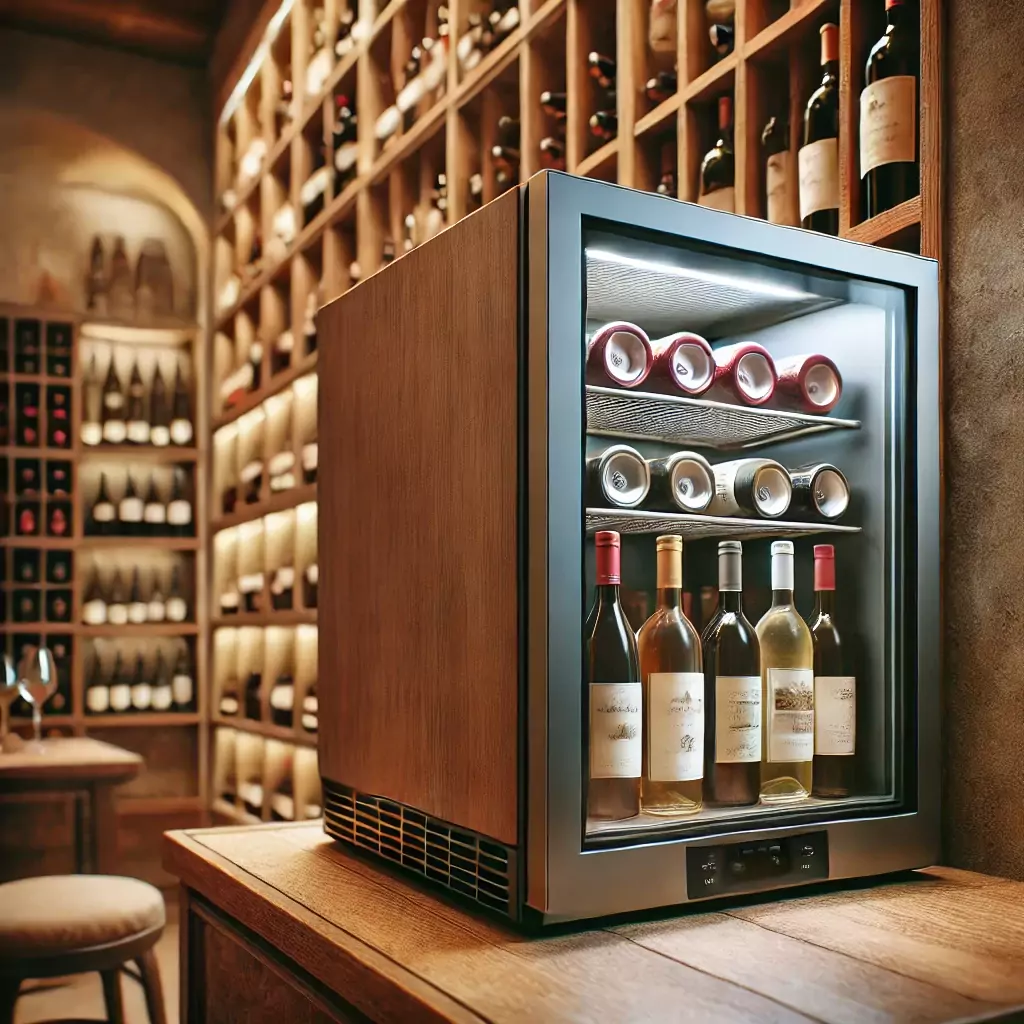Complete Guide to the Ideal Red Wine Temperature
How to Enjoy Every Glass to the Fullest?
Why the Ideal Red Wine Temperature Matters?
The ideal red wine temperature is one of the most important factors when it comes to enjoying a glass of wine at its best. Often overlooked, the temperature at which wine is served has a significant impact on its aromas, flavors, and overall tasting experience. A red wine served at the wrong temperature can alter its aromatic profile and flavor, potentially ruining even the best bottle. That’s why understanding the ideal red wine temperature is key to making the most of every glass.
Temperature Affects Flavor and Aroma
The ideal red wine temperature allows the wine’s aromas and flavors to develop in a balanced way. If the wine is too cold, the aromatic compounds “close up,” meaning the aromas are less noticeable, and the fruity and spicy flavors are muted. As a result, the wine may feel dull and lack character. On the other hand, if the wine is too warm, the alcohol tends to dominate, making the wine seem unbalanced and heavy, and the delicate nuances are lost in the warmth.
The ideal red wine temperature typically ranges from 14°C to 18°C, depending on the wine type and its structure. Lighter wines, such as Pinot Noir, are best enjoyed at cooler temperatures (14°C-16°C), while more robust reds, like Cabernet Sauvignon or Syrah, can be served at slightly higher temperatures (16°C-18°C), which helps release their complex aromas and flavors.

Acidity and Tannins Are Balanced with the Right Temperature
One of the key aspects influencing the red wine experience is the balance between acidity and tannins. The ideal red wine temperature plays a crucial role in how these elements are perceived. If the wine is too cold, the tannins can feel rougher, and the acidity more pronounced, making the wine feel less smooth on the palate. On the other hand, when the wine is served at the correct temperature, the tannins soften, and the acidity is balanced, allowing the wine to be rounder and more pleasant to taste.
Preserving the Wine’s Characteristics
Respecting the ideal red wine temperature also helps preserve the wine’s original characteristics. Winemakers design their wines with a specific profile in mind, and the wrong temperature can distort this profile. A red wine served at the correct temperature will allow the original flavors and aromas, as intended by the winemaker, to be appreciated properly, offering an authentic and complete experience. This is why professional tastings pay particular attention to this detail.
The Overall Tasting Experience
Finally, the ideal red wine temperature not only affects the wine itself but also the consumer’s overall experience. A wine served too cold or too warm can ruin a meal or a special moment, while serving it at the correct temperature enhances the experience. Whether you’re enjoying a formal dinner or a casual gathering, ensuring the wine is at the right temperature will improve the tasting pleasure, as you’ll be able to perceive its nuances better and enjoy the wine at its full potential.
Chill Your Wine to Perfection with the JINJUNYE Wine Refrigerator
❄️ Ideal Storage for Your Wine Collection: Keep your favorite wines at the perfect temperature with the JINJUNYE freestanding wine fridge, designed to offer optimal storage and cooling for your bottles.
🔒 Compact & Stylish: With a sleek countertop design, this wine fridge fits perfectly into any kitchen, bar, or living area while adding a touch of sophistication.
🎁 Perfect Gift for Wine Lovers: Whether you’re a seasoned connoisseur or just starting your collection, this wine fridge makes an excellent gift for anyone who enjoys wine.
Ideal Red Wine Temperature by Type and Body
Each type of red wine has unique characteristics that make it special, and the temperature at which it is served directly influences how we perceive its aromas and flavors. The ideal temperature for red wine varies according to its type and body, and it is crucial to enjoy each wine at its fullest expression. From lighter reds to the more robust ones, serving wine at the right temperature can make a significant difference in the tasting experience. Below, we explain the ideal temperature for red wine based on its type and body.
Light-Bodied Red Wines
Light-bodied red wines, such as Pinot Noir, Beaujolais, or some Garnachas, have a more delicate structure, with softer tannins and a more pronounced acidity. These wines tend to be fruitier and fresher, making them best enjoyed at lower temperatures within the recommended range for reds.
The ideal temperature for light red wines ranges from 12°C to 16°C. At these temperatures, fruity flavors such as strawberries, cherries, and raspberries are expressed more vibrantly, without the wine feeling flat or dull. Additionally, serving them slightly colder helps maintain the freshness and lightness that characterize these wines. If served too warm, the wine may lose its freshness and appear too sweet or heavy.
Medium-Bodied Red Wines
Medium-bodied red wines, such as Merlot, Tempranillo, or Sangiovese, have a higher concentration of tannins and acidity compared to lighter reds. These wines have a more structured profile, with complex flavors that include both fruity and spicy, earthy notes.
The ideal temperature for medium-bodied red wines falls between 15°C and 17°C. At this temperature, the tannins soften, and the flavors balance, allowing the fruity and spicy notes to fully develop. It’s important to avoid serving these wines too cold, as they can become astringent and harsh. It’s also not recommended to serve them too warm, as the tannins can become too dominant, affecting the wine’s harmony.

Full-Bodied Red Wines
Full-bodied red wines, such as Cabernet Sauvignon, Syrah, or Malbec, are more robust and have a higher concentration of tannins and alcohol. These wines typically present intense flavors of dark fruits, spices, and oak notes. Due to their structure, they require an appropriate temperature to ensure that their components are balanced.
The ideal temperature for full-bodied red wines ranges from 17°C to 18°C. At this temperature, the tannins feel smoother, the flavors expand, and complex notes such as chocolate, leather, or tobacco emerge more clearly. Serving these wines too cold can make them feel bitter or unpleasant on the palate, while an excessively high temperature can cause the alcohol to dominate, overwhelming the experience.
Aged Red Wines
Aged red wines, such as a Rioja Gran Reserva or a Barolo with years of aging, deserve special attention when it comes to serving temperature. As these wines mature, they develop more complex and smoother flavors, which requires a more controlled temperature to fully appreciate their evolution.
The ideal temperature for aged red wines ranges from 16°C to 18°C. This temperature allows tertiary flavors, such as leather, tobacco, mushrooms, and nuts, to shine in their full glory without losing the delicacy of the fruity and spicy nuances that may still be present. Serving these wines too cold can mask their complexity, while serving them too hot may cause their finer flavors to fade.
Tips for Achieving the Ideal Red Wine Temperature at Home
Enjoying a good glass of red wine largely depends on the temperature at which it is served. Reaching the ideal red wine temperature at home doesn’t have to be complicated, but it does require some care to ensure the wine is savored at its full potential. An improper temperature can cause the wine to lose its nuances, but with a few practical tips, it’s easy to control this crucial aspect. Here are some suggestions to achieve the ideal red wine temperature at home without the need for specialized equipment.
Know the Ambient Temperature and Adjust It
One of the first steps to achieving the ideal red wine temperature is knowing the ambient temperature in the room where the wine will be served. A common mistake is thinking that red wine should be served “at room temperature,” which is relative and depends on the conditions. In warm climates, the room temperature may be too high for red wine, affecting its flavor. On the other hand, in colder climates, the temperature may be too low.
To avoid these extremes, if the temperature in your home exceeds 20°C, it’s recommended to slightly chill the wine by placing it in the fridge for about 15-30 minutes before serving. Conversely, if the temperature is too low, a few minutes outside the fridge can help bring the wine to the ideal temperature.

Use the Fridge Strategically
While red wine should not be served as cold as white wine, the fridge can be a helpful tool to reach the ideal red wine temperature. Light red wines, such as Pinot Noir or Beaujolais, are best served at lower temperatures (around 14°C-16°C). To achieve this, simply place the bottle in the fridge for about 30 minutes before serving.
Robust wines, like Cabernet Sauvignon or Syrah, should be served at a slightly higher temperature (16°C-18°C). In this case, chilling the bottle in the fridge for 15-20 minutes should suffice. Keep in mind that regular refrigerators are typically set to around 4°C, so it’s not recommended to leave red wine in the fridge for too long, as it may get too cold.
Use a Wine Thermometer
A simple and effective way to ensure you’ve reached the ideal red wine temperature is by using a wine thermometer. These thermometers are affordable and easy to use, allowing you to measure the exact temperature before serving the wine. Wine thermometers can be placed on the bottle or inside the liquid to give an accurate reading. If you find the wine is too cold or too warm, you can quickly adjust it.
Techniques for Slightly Warming the Wine
If you’ve accidentally chilled the red wine too much or stored it in a very cold place, there are easy ways to bring it back to the ideal temperature. One simple technique is to hold the wine glass in your hands so that your body heat gently raises the wine’s temperature.
You can also place the bottle in a container with lukewarm water for a few minutes, but be sure not to use hot water to avoid altering the wine. Another option is to take the bottle out of the fridge about an hour before serving and let it rest at room temperature. This will allow the wine to gradually reach its ideal temperature without any sudden changes.
Common Mistakes When Serving Red Wine and How to Avoid Them
Serving red wine correctly may seem simple, but many people make mistakes that negatively affect the tasting experience. From neglecting the ideal red wine temperature to errors in how it is served, these small oversights can alter the aromas and flavors that winemakers have worked hard to achieve. Below, we highlight the most common mistakes when serving red wine and how to avoid them to ensure every glass is enjoyed to the fullest.
Mistake 1: Not Paying Attention to the Ideal Red Wine Temperature
One of the most common mistakes is not paying attention to the ideal red wine temperature. Many people assume that red wine should be served at room temperature, which can be problematic, especially in warm climates. When the wine is served too warm (above 20°C), the alcohol tends to overpower the wine, making it feel heavy and masking its flavor nuances. On the other hand, serving it too cold (below 12°C) can close off the aromas and flavors, leaving the wine bland and lackluster.
How to avoid it: The ideal red wine temperature varies by type, but generally, it ranges from 14°C to 18°C. Use a wine thermometer to ensure the wine is served within this range. If it’s too warm, chill it in the fridge for about 15-30 minutes. If it’s too cold, let it sit at room temperature for a few minutes.
Mistake 2: Overfilling the Glass
Another common mistake is overfilling the glass. Sometimes, due to a lack of knowledge or wanting to avoid refilling, people fill the glass to the brim. This not only makes it difficult to swirl the wine in the glass to release its aromas but also affects the tasting experience as it reduces the surface area for the wine to come into contact with the air.
How to avoid it: Ideally, fill the glass to one-third of its capacity. This gives the wine space to “breathe” and allows the aromas to concentrate in the glass, making it easier to perceive them while drinking. Plus, with less wine in the glass, it’s easier to swirl gently, helping to oxygenate it.
Mistake 3: Not Decanting Wines That Need It
Some red wines, especially the more robust ones or those that have aged in the bottle, can benefit from decanting. However, it’s common to serve these wines directly from the bottle, which can prevent the wine from fully opening and showcasing its potential. Decanting not only separates sediment in older wines but also helps oxygenate the wine, enhancing its aromas and softening the tannins.
How to avoid it: Decant powerful or aged red wines to release their aromas and improve their structure. This is especially important for wines like Cabernet Sauvignon, Syrah, or Barolo. Let the wine rest in the decanter for at least 30 minutes before serving to allow proper oxygenation.

Mistake 4: Storing Red Wine in the Kitchen or Near Heat Sources
Another common mistake is storing red wine in incorrect places, such as in the kitchen, where temperatures tend to fluctuate, and there may be exposure to heat sources. Excessive heat and sudden temperature changes can ruin the wine, accelerating its aging and damaging its flavor.
How to avoid it: Store red wine bottles in a cool, dry, and dark place where the temperature remains constant. If you don’t have a wine cellar or wine refrigerator, a cupboard or pantry are good options to keep the wine protected from light and heat. The ideal storage temperature for red wine typically ranges from 12°C to 15°C.
Mistake 5: Serving Wine in Inappropriate Glasses
The type of glass you use also influences the red wine experience. Small glasses or those with inappropriate shapes don’t allow the wine to aerate properly, affecting the release of aromas.
How to avoid it: Use red wine glasses with a wide bowl and a narrower rim. This allows the wine to breathe properly and the aromas to concentrate at the top of the glass, enhancing the tasting experience.
Avoiding common mistakes when serving red wine and paying attention to details like the ideal temperature can transform your tasting experience. We hope these tips have been helpful in getting the most out of each glass of wine. We invite you to keep exploring our website, where you’ll find more articles, guides, and recommendations about the world of wine. Don’t miss our blogs, packed with information to improve your knowledge and discover new ways to enjoy wine in all its varieties.
